Chris Cloney specializes in a little-known niche of industrial safety that he has built into a business.
When he came up with the idea of a 4-day virtual conference for his audience, he turned to SuperFastBusiness for guidance on the platform and marketing setup of the event.
The conference went off without a hitch. How did it come together and what can you model off it for an online event of your own? Find out in this SuperFastBusiness case study.
Podcast: Download (Duration: 28:53 — 26.6MB)
Get Notified Of Future Episodes Apple Podcasts | Spotify | Amazon Music | Android | Blubrry | Gaana | TuneIn | Deezer | Anghami | RSS | More
Episode highlights:
02:02 – There’s a market around that?
03:32 – A conference on dust safety science
04:46 – Where the money would come from
06:55 – Four days, 52 presentations, 25 countries
08:52 – How 10XPRO became platform of choice
10:44 – Not rocket science, by a long shot
14:38 – SFB helps a scientist navigate online marketing
19:10 – The gains of venturing online
21:00- The present and future of online conferences
24:33 – Some parting advice to researchers
Stay on top of the latest online business mediums with help from James
Transcription:
James: James Schramko here. Welcome back to SuperFastBusiness.com. This is Episode 737. We’ll be talking about a case study of an online conference that a member of SuperFastBusiness did. We’ll talk about why he did it, what he did, what sort of results he got. I’d love to welcome to this call Chris Cloney. Welcome.
Chris: Thanks. Yeah, really excited to be here.
James: I’m excited for you to be here. The way this episode came about is you were having a great discussion in SuperFastBusiness membership with me and the other members. You were talking about the fact that you wanted to put on a conference for your customers. And you started it as, you know, from absolute ground zero. You talked about the concept of what you wanted to do. You asked for feedback on your ideas. There were some discussions. You ran your conference. And then you posted the results. And then I said, “Chris, I would love it if you would share this on the SuperFastBusiness podcast, because it’s so instructive for other members.” In the time since you did it, which was around February 2020, you have seen the entire world’s change. And now what you did actually becomes far more relevant and pertinent and instructive.
There’s a market around that?
So first off, I just want to talk about the market you’re in, because I’ve never seen anyone in your market before. When you arrived at SuperFastBusiness membership, it was news to me that there’s even an industry around what you do. Do you want to just talk about that for a sec?
Chris: Sure. I mean, so my academic research is where I kind of came into it. I have a PhD in chemical engineering, as part of that as in industrial safety, looking at explosion hazards. So fire and explosion prevention and protection. And if that’s not niche enough, not all explosions, only explosions involving solid particles. So not gas explosions, not liquid explosions. Solid mass. So you think, if you look at your shiny MacBook Air that you have in front of you, or your laptop, that really nice fine polish on the aluminum – when they do that, it generates a lot, literally, if they’re making 230 units a day, tons of fine aluminum powder. That powder’s very flammable. If it’s allowed to to build up at the facility that’s making it, the proper safety precautions aren’t put in place, if the proper procedures aren’t followed, it can become a hazard and it can become a large explosion hazard. So my academic research was in that area.
Back in 2016, I left my job in consulting and software development, finished my PhD up and started blogging about this area that my research was in. 2017, I started building it into a business and then steadily growing since then, through a number of different avenues, all around the same topic of industrial safety for fire explosion hazards involving the solid material.
James: But in short, you’ve got something to do with dust.
Chris: Yes.
James: So you’re Dust Safety Guy?
Chris: Yeah, you got it.
James: Right. So your website is, what’s it called?
Chris: DustSafetyScience.com.
A conference on dust safety science
James: DustSafetyScience.com. There you go. So that was a new niche for me to be aware of. And what I’m always interested in is, do the things that work for our industry and for other industries that I do know about work in the dust safety industry? And you came along, and you posted this idea, you want to run a conference. What sort of customers do you have in your particular market?
Chris: Sure, so we broke it down. It’d really be, let’s say, three groups of people. My primary market with safety science was the equipment manufacturers and the consultants playing an advertising role. So I do a lot of training, a lot of education, a lot of awareness of these types of hazards. And then once the facility knows that they might have this sort of issue, then we send them off and say, Okay, well this is the equipment you probably should be working with to get safe solutions. This the consultant for maybe what to work with to get a hazard analysis done.
The conference was really a way to start bringing the other side of the market as well. So the facilities, the end-users, the health and safety managers, the engineers, the people that are doing operations and maintenance at the facilities they want educational training as well. And we’re really serving them in a monetized capacity. So the conference is really bringing these experts together on one side, bringing the facility health and safety managers and those types of folks on the other side, and starting to broaden who we’re delivering to from dust safety science in general.
Where the money would come from
James: Who would pay for the conference?
Chris: Well, funny thing about this, everyone. So the attendees were generally facility owners, facility operators, health safety managers. They paid a price to attend the conference. But we also charged the speakers. So we had over 40 speakers, and we charged them a higher price. It helps to get their expertise, it’s branding and marketing for them to get out in front of the audience as well. So those would be the two big groups that attended the conference.
James: Yeah. I’ve seen this happen before, especially in the education market, where you have schools paying for teachers, and then you have teachers also paying to get extra academic qualifications. I’ve got two clients in that particular space in different ends of the market. One teaches technology, the other one teaches PE.
You said there were three markets. What’s the third one?
Chris: Well, the provider side is services and equipment. So safety equipment would be one part of the equipment realm. And then people are providing consulting services.
James: And do you get them to sponsor or pay in some way as well?
Chris: Yeah, that was our main revenue model up until we ran the conference earlier this year, was through we write reports every six months, we have kind of magazines sell advertising in there. We have an advertising membership with about 30 companies that pay annually to be featured on the website. We have profiles there, people search for particular equipment or particular safety solutions on our website, those companies will come up. So those are really where our biggest clients up until we ran the conference that started this year.
James: Great. Well, that’s actually is similar to my market. I had more or less those three income components for my events where I have a sponsor, I have a business owner sending their team, and then I have individuals wanting to skill up. So this is really instructive. In fact, one of the people I used to sell Mercedes-Benz to had a publishing company, and he was in the safety industry. And he used to go around to building sites and give them posters to put up on the building site walls that were safety diagrams that had illustrations and pictures. And he would get endorsed by the government body that was responsible for health and safety, they would send them out as well. And what he would do is sell the border around the edge of this map, or these diagrams, to the equipment providers. So all the ladders and the helmets and the gloves and the tools, etc, would all be paid for by the sponsors. So, really replicable model here.
Four days, 52 presentations, 25 countries
So you’ve decided to run this conference to educate the people who are working in the places. You’ve got paid by three separate people. How many presentations did you have and over how long?
Chris: The event ran four days, on the last week of February 2020. And in that time, we had 52 presentations. Basically, back-to-back keynotes were an hour long. I did five presentations myself, so three, three hour-long keynotes, two half-hour presentations, and then the other 47 were all given by other experts in the field. So long days, eight-hour days, almost back-to-back, with like an hour lunch break. We really set up like a real physical in-person conference, which had positives and negatives. That made it hard to organize, but it actually went off flawlessly, which I was pretty surprised. I figured at least a one or two-percent failure rate. But every speaker showed up, no technical glitches, no jumping out, no lost slides. Every video worked. People had in their presentations and it just went off, really, without a hitch.
James: That’s amazing. And you had people from 25 countries.
Chris: Twenty-five countries, 12 time zones. Yeah. I was stunned as we went to the second and third days. And we actually had a storm here in Nova Scotia in Canada, where I’m from. On the last day, the 52nd presentation, my power flickered halfway through, which would have dropped the line for everyone. But it stayed on. And yeah, we made it through all the presentations without any dropped calls or anything.
James: Now, we don’t have to talk about numbers, but you made a substantial sum from this conference in terms of revenue, and I imagine a good chunk of that is going to be profit.
Chris: Yeah, a big chunk. Really enough to sustain my team for the next five, six months as we continue to grow the rest of the business model that we’re developing.
James: Very nice. And I’m just keeping some confidentiality around it. Because you know, this is good IP you’ve developed in your industry. But I’ve seen the number, and members of the forum have seen the number, and it’s a substantial number. So congratulations.
Chris: I appreciate it.
James: You also back-ended this with some access to a membership. We want to talk about that. So this is the category of things around the conference in terms of the business model that might continue to pay for you.
How 10XPRO became platform of choice
Chris: It actually ties in with the platform we use. So we use kleq as the platform to house the conference. We ran everything through Zoom in terms of the webinars, but we built the whole platform on 10XPRO, for people to attend the webinar. So basically, only part of it that was on Zoom was when you clicked Attend this session, it would take you off to Zoom.
But the kind of rewinding back to about six months before we ran the event and we were trying to plan it out, trying to find platforms to use. We looked at all these academic platforms, had them written down, ON24, HeySummit, vFairs, and I couldn’t even get into, like get a demo of the thing.
So I saw John Lint, I’ve listened to your podcasts with him. So I went to 10XPRO, paid $1, got in. And literally within half an hour, I’d mocked up what this amazing platform could look like to run an event in. I actually got five whiteboards out and just basically did a whole, not a 180 of my business plan, but took my five-year plan of what Dust Safety Science could be, which eventually is now Dust Safety Academy through this training platform. Condensed that five year plan down into, holy smokes, if I run this event, we can kind of be at that five year mark in six, eight months from now. The plan there was, everyone that attends the event gets access to the Dust Safety Academy platform for six months after. So we’re just right now moving into monthly trainings, monthly ask me anything sessions, again bringing in experts from around the world. And everyone who attended the conference has basically that ticket for six months. And we’re still making sales, about another 10 or so people signed up just over the last couple weeks after the event to catch the replays as well.
But in terms of the model, that was the ongoing part of it. So we really front-ended it, something I learned from you. I know you did this back, from listening to your earlier podcasts with Ezra Firestone and other folks, where you would run an event and then on the backend provide free access to your membership. It’s basically the same thing, but I didn’t actually have a membership.
James: And now you do.
Chris: We’re jumpstarting the membership with those people. Yeah, exactly.
Not rocket science, by a long shot
James: Do you have to be a professor to understand it?
Chris: Understand the technology behind dust explosions, or understand 10XPRO?
James: 10XPRO. I know you have to be a professor to understand dust explosions. That’s not even a question. But you know, someone listening to this, I’m just thinking that well, okay, this guy’s got a PhD. He’s a smart guy. He’s figured it out. But what about poor old me? Can a normal individual who hasn’t got such accolades still navigate the platform?
Chris: Well, I appreciate that. But the short answer is, it was amazingly simple, especially after I’d looked at these other platforms that were extremely complicated. I did get a demo of one of them, not sure which one I got in. I couldn’t even figure out how to set up like a button. I wanted this to play with things, and I couldn’t even do it.
James: I’m laughing because I had a chat with John from 10XPRO about some of these platforms. I showed him some of them I said, “Look, this is what people are looking at in the marketplace.” And he just went off on a long conversation about how 10XPRO does everything they do, but just simpler and easier and even more powerful, that some of them are very hard to use for sure, and quite limited. But I think the long play for you, as you’ve said, is using the event not as the end goal or the end product, which a lot of people do with their launches, but using it as the starting point.
And I see typically 75 percent of my members who buy a ticket to an event will become members of my membership, through that conversion process of making them an offer, simply putting it into the funnel. They’re now indoctrinated into your world, they like what you do, they want ongoing solutions, they do stick around, and they will compound over the years. If you do another online event, you’ll have a high representation of your actual members in there at the next one, plus you’ll bring in new people from the public.
Chris: Yeah, I agree. And that’s the part I’m really excited about. I just got to say, on 10XPRO, to mock it up was, you know, 15 minutes. I didn’t have the imagery. Our designer actually made it look nice later, but just to put in, you know, stock photos. But the real power was, I clicked in and went, Okay, how do I do a sales funnel there, put in a sales sequence or a funnel? And it was already there. It was one click, I could see how it was done. I’m like, Oh, this can be really easy. Integrate Stripe and you’re done. Same with email integration, one click on the page and you’re firing off tags to ActiveCampaign or wherever you’re going to. And I could see within 45 minutes that this had the power to set up what I wanted my business to look like one, two, three, four years in the future. That’s where we’re at today, now I have that set up with the 250-so people plus more people coming in. It’s just a matter about building Dust Safety Academy up now.
“Click a button to get going, and then customize design later.”
James: That’s phenomenal. We set up an installation on SuperFastResults.com, which original members of SuperFastBusiness will remember with kind love, because that was the original version of that membership on that domain. And we’ve resurrected that domain for our standalone products. And it’s a 10XPRO installation, and I’ve just been loving working with the team on it. And I think you mentioned something vitally important. You can click a button to start and get going, and then you can actually customize design later. It’s extremely customizable, but it’s optional.
Chris: Yeah, I couldn’t agree more. You’ve been hitting on this 10XPRO installation, but I don’t think you’ve released on the podcast yet. So I just fired up SuperFastResults because I was excited to see where it was housed at. So I’m getting a sneak peek, because this won’t come out for a bit.
James: You are. As we record this, we’ve got the sort of final revisions of the page is still being done. But by the time this gets published, it’s fully up and running. So yeah, it’s one of two installations I’ve got. I’ve got one outside the online space that I’ve been keen to do for a long time. And the thing that was holding me back was I was groaning at the sort of setting up another stack that replicates what I’ve got at SuperFastBusiness, which is my sort of legacy situation, nowhere near as easy to do it.
So every time I sit down with John, I’m like, “John, can you make it do this? And does it do that?” And he’s like, “Yep, does that.” And he’s got training for absolutely everything. My team has found it extremely easy to use. I’m in the luxurious position of not having to even log in to any of it. But if I was a solo operator, that would still be quite viable, from what I’m hearing from each of the case studies.
SFB helps a scientist navigate online marketing
Now, I’m interested from your perspective. Like, clearly, you’ve got some clues about what I’ve been doing, and you got some really good feedback and input and support from other members of SuperFastBusiness while you were going through this. How important was it for you, coming from a scientific world, an academic world, to find this little portal of online marketers who is there to support you?
Chris: Well, I mean, it’s been phenomenal for me. I think about how the conference went. I did direct emails, I sent about 100 emails and sold 50 tickets that way. But the actual first page I set up as a sales page, as an online sales page, through my Dust Safety Science website, it was just not good. It was converting at maybe point two percent. I looked and did the math and realized that we wouldn’t even get enough attendees. We had to have more attendees than we’d have speakers. This was early December. So three months out, and going into the Christmas season. So I came up with a new strategy and marketing plan. That’s when I posted in SuperFastBusiness and said, well, actually I wrote – I threw it into Word and got the words here. So I wrote an 825-word post, just summarizing status, where it’s at, and asking questions at the end.
James responded with 36 words.
James: You got a long answer from me.
Chris: But the amazing part was the 36 words were, like, the most important ones. So I had, website captures a question. Use a Hello bar and exit popup. What should I do for my email sequence? Send a sequence of the hard deadline every, each month. So we set it up. We had eight weeks left to go before the conference at this point. So I create eight emails, send it out. And just the 36 words actually led me to going from a point where I was at maybe 1000 people viewing the sales page in a month and converting at .02, .03 percent, to a sales page that’s converting at 5 percent to 8 percent. And, you know, we had 2,000, 3,000 views of the sales page. So that’s how we got our extra 200 people.
But it was from those 36 words. I mean, we built on them, I’d do mockups and show them to the community and get feedback from folks like Jarrod Robinson and other people that were posting within the community on that thread. But the crux of it was those first 36 words just saying, do this, this, this and this. So I spent my Christmas break, mocked up this, this, this and this, sent them back one at a time, you said okay, and I reported on it the whole way through. And that’s how it kind of turned into a case study thread on what we’re now finally calling virtual summits, because everybody wants to do them now with all the Corona virus going on.
James: Everyone wants to do them, and you were doing it. And it went from you asking for feedback to, I did rename it as a case study and I posted it as a sticky, as a shining example. Like, if you would have put a number on what it’s meant for you to be inside SuperFastBusiness, has it ever sort of come to mind?
Chris: It does. There’s different users of kind of memberships like this. I’m not the type of person that goes and watches every live training and do all that. I sort of get my quick hit and then jump out and get my quick hit and come back out. But just from that, I picked out a couple. And I think I can give these away on the podcast. You may have given them away publicly before, but things like increasing your membership price to retain previous members. So I did that on my advertising membership.
James: Loyalty lock-in, I call that.
Chris: Yeah, exactly. And so I did that when we were renewing our first annual members for the advertising membership, and that had 100 percent conversion. Ten out of 10 companies re-opt for over $2,000 each. So that was a big chunk of money coming in from that. And then all the new members are paying at the higher rate. And we had very little turnover in that membership, from 30 companies now, and I think we’ve had maybe two companies drop out in the last three years of running that. This conference itself was 60, 70,000 range. Just doing the numbers for the investment I made early on, I’m over $100,000 in revenue from these tips I really received from SuperFastBusiness, from the members, just asking questions. And the crazy part is, I don’t watch all the trainings. So I’m kind of at a point now where I’m like, Okay, I need to set aside four hours a week or two hours a week just to jump in and do the deep learning. But I feel like I’m still scratching the surface of the amount of stuff that’s in there.
“It’s not about having the most things to do. It’s about doing the right things.”
James: And that’s good. Look, it’s not about having the most things to do. It’s like, I take from Peter Drucker, it’s about doing the right things, and if you can just get a simple directive on, these are the right things. You’ve got such a rich tapestry of experience in there.
Jarrod Robinson runs so many summits and webinars and automated them all. He’s a whiz kid. I’ve run live events for 11 years. And the thing that I’m doing right now from SuperFastBusiness Live is I ran a webinar for members recapping the event. And then I’ve also simulcast that as a podcast. And then in that podcast, I mentioned that all the recordings from the event are inside SuperFastBusiness membership, and that they’re available from just $99. And that is how you bring in new members.
The gains of venturing online
You’ve leveraged that event that you did and made it pay multiple times in the future. You’ve actually got paid to create content. And now you have the ability to market those individual trainings or snippets of them out in the public as top of funnel content. You’ve got now a platform that is everything in one that you need aside from ActiveCampaign, which is a very great pairing. And so you’ve simplified your tech stack. You’ve brought forward your business model by years. And you’ve got an audience there who are hungry for more help ongoing.
“Online conferencing is a hot market right now.”
And I imagine the future’s looking bright for you now that you’ve nailed the online thing, notwithstanding the fact that there’s any number of people who would love to get that similar kind of help in whatever they’re doing. This online conferencing thing is a hot market right now. And you nailed it even before it was mandatory.
Chris: Yeah. It kind of comes back to own the racecourse theory. At the end of the day, I could have used any one of these webinar, conference-running platforms where it was all on their system. But when I got in and built it on 10XPRO, even though we didn’t run the webinars on 10XPRO, which we’re working on that integration now, but everything’s on our platform. We have all the emails, we have the sales, we have everything because we built it out in 10XPRO. 10XPRO’s not set up necessarily to run this kind of event. So you have some funny things, like things are called courses that aren’t necessarily courses. They’re event pages.
James: You might see some little changes there. He just did a brand new course called Streaming Like a Boss. He’s got a summit, online conferencing type material now, and I think he’s paying attention to what the market wants in that regard. And most definitely, you can do the streaming inside the platform. We just recorded an episode about that. And that’s how he does his training each week. So if you wanted to – and the cool thing is he’s using platforms that don’t cost any money extra – you can take advantage of the same platforms the world’s most notorious streamers use, that are pretty much free, which is great.
The present and future of online conferences
So I’ve seen in the stock market and the press a little bit of a backlash for some of the webinar conferencing softwares relating to security and privacy and so forth. You don’t even have to worry about that if you don’t want. You can have an unlimited number of attendees, if you happen to be in a mass market. Tens of thousands of people can be supported by huge platforms like Amazon via Twitch or Google via YouTube. So there’s pretty exciting developments in that regard.
Chris: I couldn’t agree more. And the choice to use Zoom was the difficulty with organizing and test run. It took us a whole week to do test runs with all the speakers, that’s how it came off so flawless. But we were worried about them needing to, they’re not necessarily extremely tech savvy people. And it’s a complicated process to organize that many speakers. So I knew Zoom worked, I’d use it for podcasts forever. And a lot of people that were speaking, I’d done podcasts with before. So I knew they were kind of comfortable with it. We just looked at some of the integration options and just worried that any extra steps were going to cause some failure rates.
But that being said, it’s a totally different world. I mean, I only ran the conference six weeks ago, four weeks ago in North America. I’ll give the anecdote of it. I ran the conference. I went to Florida for vacation the week after, got home. First day I got home, I put my son in daycare, within 24 hours realized the world is going down fast and had to self-quarantine at home with my son for the next 14 days. And he hasn’t left. I mean, we leave the house a little bit. But really, we haven’t left the house since the world has completely changed in terms of interacting with people. And we’re getting emails from huge pharmaceutical companies and other companies in our space saying, “How did you do this? How did you run this conference? Because we have our annual conference for our company that we can’t run anymore. So we want to run it virtually.” And I’m posting that on SuperFastBusiness too. We’re not in the business of running online conferences for anybody. But that’s a new space that I’m sure is just blowing up and people will be in.
James: Massive space. Even the guy who was recording my conference is gone straight into the online conferencing. The episode just prior to this episode, we were talking about, in fact, there’s a number of episodes talking about going from physical to online. This is the place to be. I mean, just happened to be in the right place at the right time. I would say you’d have to be a little more confident about your business in this climate than what it might have looked like a few years back.
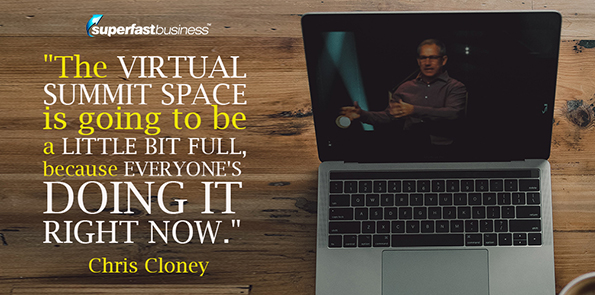 Chris: Well, an amazing part is, I think the virtual summit space is going to be a little bit full, because everyone’s doing it right now. But I have a ton of people emailing me saying hey, my employees are off, they’re working from home. Do they have training available? And now I say, well actually, we just did the first draft of the ongoing training sales page today. I saw the first drafts of it. But I’m just at the stage where I’m going to be saying, Yes, we have live training every two weeks. We have replays that are all available inside the Dust Safety Academy community. And that’s going to be really powerful, to have your own membership, have your own community where you can house this, especially if you’re willing to put yourself out there and become known as the best in your space, or known as the most knowledgeable in your space. Which is something I think a lot of academics, a lot of researchers can do, especially if they’re already had that background in these, you know, really niche areas.
Chris: Well, an amazing part is, I think the virtual summit space is going to be a little bit full, because everyone’s doing it right now. But I have a ton of people emailing me saying hey, my employees are off, they’re working from home. Do they have training available? And now I say, well actually, we just did the first draft of the ongoing training sales page today. I saw the first drafts of it. But I’m just at the stage where I’m going to be saying, Yes, we have live training every two weeks. We have replays that are all available inside the Dust Safety Academy community. And that’s going to be really powerful, to have your own membership, have your own community where you can house this, especially if you’re willing to put yourself out there and become known as the best in your space, or known as the most knowledgeable in your space. Which is something I think a lot of academics, a lot of researchers can do, especially if they’re already had that background in these, you know, really niche areas.
James: Right. And the best time to do this was earlier than now. And the next best time is now.
Chris: Now.
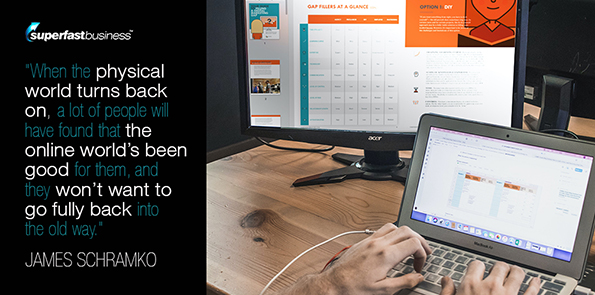 James: So you’re already in it. You’ve got a head start. The online subscription services space has gone up 61 percent, so it’s the go zone. Make those products. Exactly what I’m doing. I’ve got those products out, they’re information products. People are consuming online information. They want to learn, they want to skill up. The online space is hot, we’ll have lots of entrants into the market. I think when the physical world turns back on, what we’ll see is a lot of people find that the online world’s been pretty good for them, and they won’t necessarily want to go fully back into the old way. There’ll be a different shape. If it used to be a triangle, it’s going to end up being a circle, like it won’t go back to being a triangle. That’s sort of a simple metaphor. We’re a different-shaped world. This is the go zone.
James: So you’re already in it. You’ve got a head start. The online subscription services space has gone up 61 percent, so it’s the go zone. Make those products. Exactly what I’m doing. I’ve got those products out, they’re information products. People are consuming online information. They want to learn, they want to skill up. The online space is hot, we’ll have lots of entrants into the market. I think when the physical world turns back on, what we’ll see is a lot of people find that the online world’s been pretty good for them, and they won’t necessarily want to go fully back into the old way. There’ll be a different shape. If it used to be a triangle, it’s going to end up being a circle, like it won’t go back to being a triangle. That’s sort of a simple metaphor. We’re a different-shaped world. This is the go zone.
Some parting advice to researchers
I just want to say how generous you are to come and share this. You didn’t have to. You’re not an online marketing expert, you’re a dust scientist, you work with explosions. And you’ve innovatively found a way to serve your market better. You’ve generously shared your insights. What would be your sort of summary tips to advise someone who is perhaps an expert like yourself in an unusual or not so common market where they have a chance to be an online leader? What would be sort of the go-to steps?
Chris: Well, a couple of things is to realize that there’s some different genres you can take. So you can be R to P, so researcher to public; R to R, researcher to researcher, or you can be R to B, researcher to business.
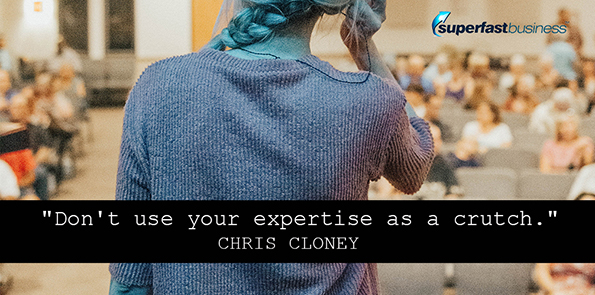 But a lot of researchers don’t really realize those are different options. The researcher to business space, which is what I’m doing, can be very lucrative. And I’ve actually used that to turn into, now we have a profitable business. I call it self-tenured. So tenure for university, you’ve got to work there for 30 years and eventually they give you tenure and then they can never fire you and you have this job forever. But you build a profitable business that is not based on government grants, you don’t have to fill out those kind of loans, but based on actually a profitable business model. We funnel that back in. So this year, we’re building a Dust Safety foundation. It’s supporting masters and PhD students. It’s also supporting the families suffering loss from this type of explosions around the world. But I’ve built, like, my own little university, because I’ve been willing to go out there and be, to have the knowledge and the information, but also get good at marketing and selling it and building a profitable business and building business models into it that can then funnel back into what we what we do and the change that we make in the world. So I say, realize there’s some different business models you can take. Don’t use your expertise as a crutch.
But a lot of researchers don’t really realize those are different options. The researcher to business space, which is what I’m doing, can be very lucrative. And I’ve actually used that to turn into, now we have a profitable business. I call it self-tenured. So tenure for university, you’ve got to work there for 30 years and eventually they give you tenure and then they can never fire you and you have this job forever. But you build a profitable business that is not based on government grants, you don’t have to fill out those kind of loans, but based on actually a profitable business model. We funnel that back in. So this year, we’re building a Dust Safety foundation. It’s supporting masters and PhD students. It’s also supporting the families suffering loss from this type of explosions around the world. But I’ve built, like, my own little university, because I’ve been willing to go out there and be, to have the knowledge and the information, but also get good at marketing and selling it and building a profitable business and building business models into it that can then funnel back into what we what we do and the change that we make in the world. So I say, realize there’s some different business models you can take. Don’t use your expertise as a crutch.
And I did it kind of here too, right? I said, Okay, I’m going to do this really sales space that looks like most academic conferences. So I looked up, you know, my favorite academic conference, and did the sales page like that and it sucked. And it wasn’t until I went to SuperFastBusiness and asked how I should design that sales page and I actually mocked it after SuperFastBusiness Live. That was one of your 36 words, was the link to that sales page. I mocked up the same two-video setup. I actually sat on a coach just like you and your video, although I needed boxes and webcams and cords to get the shot right. But I did a more online marketing-based sales page. And I was really worried that, you know, other researchers, the industry wouldn’t like because they’re not used to it. It turns out, there’s a reason that it works in online marketing, because it works a lot better.
So don’t use that you’re not in the space or that you’re outside the crux to automatically say that you shouldn’t do that. Because a lot of time you’re just doing it because you’re hiding from doing the real hard work, which for me was to set up my webcam so I could sit on the couch, shoot the video, get it edited and get the whole new sales page up. If you use that as a crutch, you really have a chance to not get anything done, because you’re always hiding behind, this isn’t how it’s done in my market, which is very different than most online marketing spaces.
“Whatever the market was, it’s not going to be that anymore. It’s time to make a change.”
James: That’s really my point. Whatever the market was, it’s not going to be that anymore. Time to make a change.
Chris: Yup.
James: You’ve done it. You’ve shared your knowledge. You’re a dead set legend. That’s what we would say in Australia. And Chris Cloney, I appreciate what you’ve shared with us. And thank you for being a member and thank you for being so generous.
Chris: Awesome, James. I appreciate it and I appreciate everything you do. Like I said, my business has grown exponentially, at least once through the membership and then probably exponentially again, if you look at where this is heading with the Dust Safety Academy and with the community that we built there.
James: Well, I think if you work your way through some of the recordings from SuperFastBusiness Live, you will go for a massive next stage. There’s some absolutely insane content there, especially around the traffic puzzle. I’m thinking especially for you. You just got so much to look forward to, and I can’t wait to see what that journey looks like. Maybe we’ll have you back in a while and talk about the next evolution. I love to have people back to share their continued journey. So Thanks, Chris.
Chris: Thanks, that’d be fantastic. And I’m looking forward to it.
James: Awesome. This is Episode 737. We’ll break down some step-by-step plans if you’re planning to do some kind of online conference, so that you can remember to serve your different markets, monetize it before, during and after the event, and we’ll share what platforms are being used, etc. And this has been a really great episode.
Get the resources you need to realize your business vision inside JamesSchramko membership
Enjoyed the show? We’d appreciate a review on iTunes
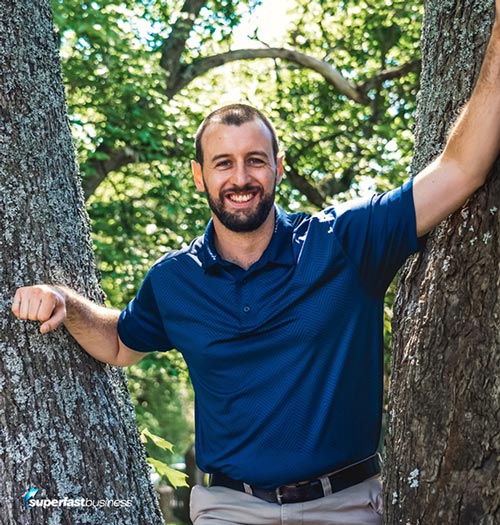
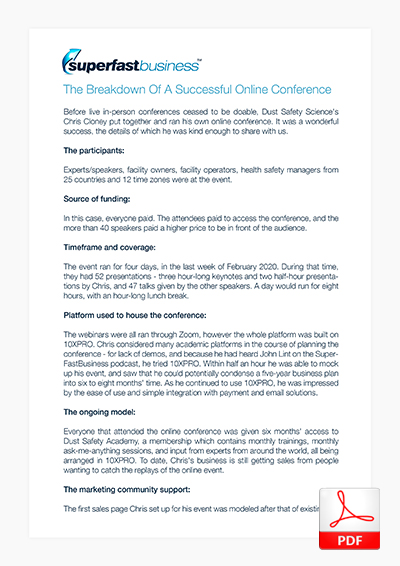


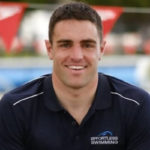






Thanks James & Chris for a great podcast. I’m in the event industry and having the same challenges of finding the right platform that is easy and doesn’t take 4 weeks just to even see a demo.will be checking out 10XPRO
4 weeks is a lifetime online!